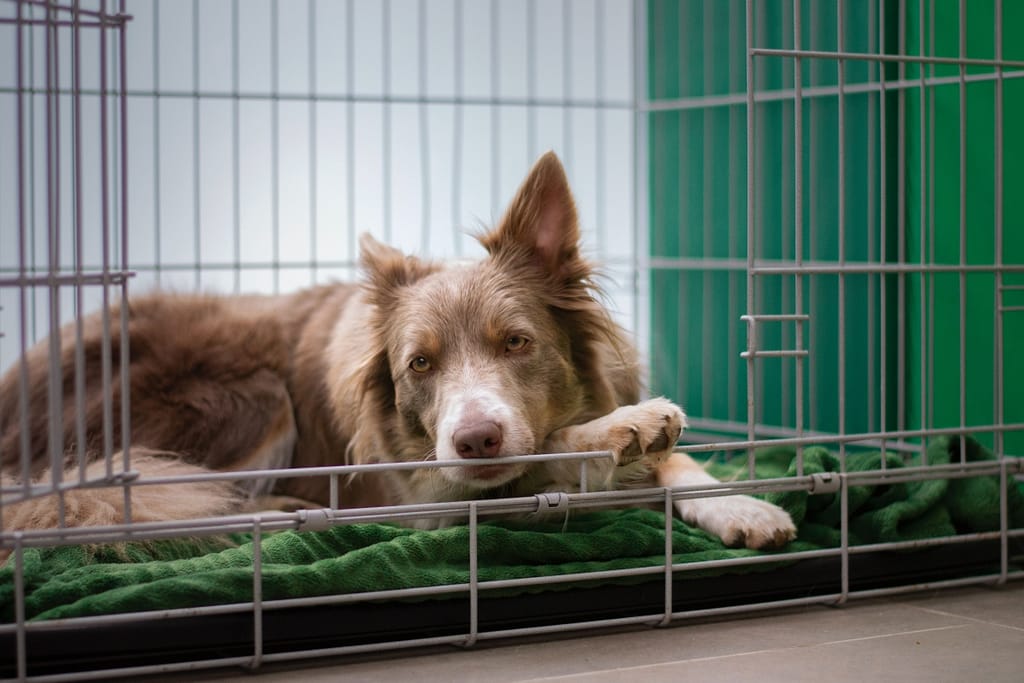“Should I crate my dog?” is one of the most frequently asked and debated questions in the dog world. The way a crate is used for a dog is a deciding factor on whether the crate may be a prison for dogs or a safe haven. Crates are the human version of dens that help dogs learn how to behave well and to cope in the world they are living in. Crate training is one of the foundational exercises to raising a more respectful, tuned-in dog.

Does every dog need to be crate trained?
The short answer to this question is No. Not every dog needs to be crate trained. Crate training is a highly recommended training practice to ensure your dog’s safety, prevent accidents, accelerate potty training, and help a dog settle down. But there may be numerous scenarios where a dog may do better without a crate such as when the dog has severe separation and/or crate anxiety to the point of self harm, when the dog has grown up with terrible association with the crate, if the dog needs a bigger space when confined, etc.
When done correctly, crate training has a plethora of benefits and can be a serious game changer in your dog’s training journey.
7 reasons why you should crate train your dog...
- Nips certain behavioral issues in the bud
When dogs are not trained to handle independence and separation from a young age, they may end up with behavioral issues like separation anxiety, isolation distress, destructive chewing, whining, barking etc. At times these behavioral issues may escalate to the extent of the dogs hurting themselves.
Crate training when done correctly from an early age teaches puppies to associate the crate with rest and relaxation and cope better on their own. This forms a strong foundation in order to raise a puppy into a calmer and a well-behaved dog. It also prevents issues like isolation distress and separation anxiety from ever taking place.
- Helps in independence training
Clinginess in puppies stops being cute when it translates in behavioral issues like separation anxiety, boredom, barking, whining etc. The main cause of these issues is deeply rooted in the dog’s inability to be independent. A crate helps in habituating the puppy from a young age to cope with independence and isolation.
When a dog associates the crate with fun and games, he would look forward to stepping into it willingly. Furthermore, being busy with mental enrichment activities inside the crate teaches dogs the art of self engagement. Puzzle toys, interactive games, slow feeders, long-lasting chews, etc. rely less on human involvement and more on the dog’s inclination and ability to interact with them.
- Aids in potty training
Crate training and potty training have a direct correlation with each other. As a general rule, dogs do not soil where they sleep (unless they have a medical condition or are clueless about their pee/potty spot). Once the dog associates the crate with a resting space, they avoid soiling it. Crate training also helps in preventing potty accidents and promote better bladder control, two of the most important factors in achieving potty training success.
It is also crucial to remember that puppies have a tiny bladder and need to relieve themselves time and again. Thus, locking them in the crate for several hours is a sure shot way for the whole exercise to backfire.
- Teaches dogs to calm down effectively
Puppies are born with miraculous amounts of energy, more than enough for them to take on the world. Allowing them to engage in boisterous play without giving them enough time to calm down c from time to time can result in hyperactivity and overstimulation. This usually translates into behaviors like excessive jumping, biting, nipping etc.
Crating a dog after extended (or even shorter duration of) play can help dogs take an effective breather. This is essential in making sure that their hyperactivity is not leading to anxiety or other behavioral issues. The confined safe of the crate enables puppies to self-soothe and helps them be comfortable with confinement.
- Keeps your pup safe
Dogs are one of the most accident-prone pets. Their curiosity and playfulness often lead them into trouble. They can go from playing with something to choking on the same thing in a matter of seconds. For this reason, it is highly risky to give them free range of the house without supervision.
Crates act as safety schools when you are not around to supervise your fur baby. Depending on the resources made available to them in there, crates can help keep a dog engaged for short to long periods of time. A dog in a crate is a sure shot way to a pet parent’s peace of mind that they are okay when left alone.
- Helps dogs settle down faster in new places
It is a living being’s natural survival instinct to try and find familiarity in unfamiliar places. Dogs who feel comfortable in crates are able to settle down in new places faster than dogs who aren’t comfortable in confinement. This is because these dogs have grown up forming a positive association of safety and relaxation with crates. This association helps them settle in faster in newer in places like pet sitters’ home, boarding facility etc.
On the other hand, dogs who get anxious in crates take a longer time to settle down in newer places. This is because they have a negative association with the only thing that is supposed to make them feel safe.
- Makes travel safer
Not all dogs are born with an inclination to ride in vehicles. Unfortunately, a lot of them get car sick and are miserable in moving vehicles. Constant moving around and whining at the back seat or passenger seat by a dog that is not in his crate can cause serious disruption to the driver and can be downright dangerous. It can be tempting to let an anxious dog rest their head on your lap, but it may do more harm than good as their safety may be at stake.
Crating the dog during car rides can help improve overall travel safety. A dog in the crate has no other option but to settle down. This can help reduce car sickness. game changer in your dog’s training journey.
2 things not to do while crate training your dog
- Using it as a time out/ punishment zone
Using it as a time out zone is one of the most common misuses of the crate and a classic way to make a dog hate the crate forever. It will undo all the hard work you’ve done teaching your dog to love being inside. Furthermore, it has been proven that using crates as time out zones may increase the anxiety of an already anxious dog.
- Isolating your dog in there for a several hour stretch
A crate is an excellent tool to keep your dog safe when you are not around for a few hours. However, it is cruel to leave a dog in there for over 8 hours long without a break. If you are going to be working long hours, it is advisable to hire a walker or ask a friend to visit your dog during the day and let them out of the crate for a much-needed break.









